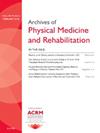Exploring Geospatial Barriers and Facilitators to Community Integration Among Burn Injury Survivors 4354
IF 3.6
2区 医学
Q1 REHABILITATION
Archives of physical medicine and rehabilitation
Pub Date : 2025-04-01
DOI:10.1016/j.apmr.2025.01.049
引用次数: 0
Abstract
Objectives
To explore the spatial disparities in community integration (CI) of burn injury survivors in North Texas and identify barriers and facilitators to inclusion.
Design
A cross-sectional study analyzing data from the National Institute on Disability, Independent Living, and Rehabilitation Research, this study conducted geographical information system mapping to assess neighborhood characteristics for better CI.
Setting
The study is set in the general community of North Texas, using outpatient medical data records to analyze the environmental context of CI among burn injury survivors.
Participants
Participants include burn injury survivors from North Texas, managed by the UT Southwestern Medical Center. We studied 285 adult patients hospitalized between 2015 and 2022.
Interventions
Not applicable as this study is observational, focusing on existing data analysis rather than implementing new interventions.
Main Outcome Measures
The primary variable under examination in this study is the CI score, provided by the BMS database. These scores are derived from questionnaires that assess various dimensions of community engagement, including financial support, shopping habits, participation in leisure activities, visits to friends and relatives, social interactions during leisure activities, and the presence of a best friend. The CI score, ranging from 0 to 12, serves as an indicator of the level of CI, with higher scores indicating stronger integration. To analyze changes in CI over time, we computed the average CI score for each county in North Texas at the time of discharge and 6 months after discharge. The difference between the CI score at discharge and 6 months later was then calculated to determine whether integration scores increased or decreased. Subsequently, we visualized these changes at the county level before and after community reentry.
Results
Counties with improved CI scores display higher levels of educational attainment, enhanced health care access, superior transportation infrastructure, and increased availability of nutritious food, alongside improved public safety measures. Additionally, these counties demonstrate lower levels of racial segregation and reduced exposure to environmental stressors such as extreme heat, sunlight, and UV radiation.
Conclusions
Enhanced community-based interventions and policies are recommended to improve CI for burn injury survivors in North Texas. Additional research is needed to further refine these recommendations.
The authors received funding from the National Institute on Disability, Independent Living, and Rehabilitation Research (NIDILRR). However, the opinions presented in this document do not necessarily coincide with the policies of NIDILRR, nor do they automatically receive endorsement from the Federal Government.
Disclosures
none.
求助全文
约1分钟内获得全文
求助全文
来源期刊
CiteScore
6.20
自引率
4.70%
发文量
495
审稿时长
38 days
期刊介绍:
The Archives of Physical Medicine and Rehabilitation publishes original, peer-reviewed research and clinical reports on important trends and developments in physical medicine and rehabilitation and related fields. This international journal brings researchers and clinicians authoritative information on the therapeutic utilization of physical, behavioral and pharmaceutical agents in providing comprehensive care for individuals with chronic illness and disabilities.
Archives began publication in 1920, publishes monthly, and is the official journal of the American Congress of Rehabilitation Medicine. Its papers are cited more often than any other rehabilitation journal.

 求助内容:
求助内容: 应助结果提醒方式:
应助结果提醒方式:


